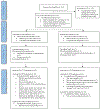Evaluating the Efficacy of Eradicating Gardnerella vaginalis Vaginal Colonization With Amoxicillin: A Randomized, Double-Blind, Phase 2 Study
- PMID: 34475360
- PMCID: PMC9506839
- DOI: 10.1097/OLQ.0000000000001555
Evaluating the Efficacy of Eradicating Gardnerella vaginalis Vaginal Colonization With Amoxicillin: A Randomized, Double-Blind, Phase 2 Study
Abstract
Background: Research suggests that Gardnerella vaginalis (GV) is the keystone pathogen in bacterial vaginosis (BV). Knowledge gaps exist regarding the role of GV eradication in the development of BV. This study was designed to test the hypothesis that vaginal colonization with GV could be eradicated by treatment of women without BV with amoxicillin, a drug highly active against GV. If GV is necessary for the development of BV, then eradication of GV may prevent the development of BV.
Methods: We conducted a randomized control trial of amoxicillin 500 mg twice daily versus placebo for 7 days in women aged 18 to 45 years without vaginitis who screened positive for vaginal colonization with GV by quantitative polymerase chain reaction. Test-of-cure visit for GV was conducted at day 21.
Results: One hundred seventy-two women met preliminary criteria and were screened for enrollment. Ninety-seven GV-positive women were randomized to receive amoxicillin versus placebo. Eradication of GV occurred in 21% of women randomized to amoxicillin versus 16% on placebo (P = 0.757). In the 4 weeks between screening and test-of-cure visit, 16 of 92 (17%) of participants developed Nugent scores greater than 3 with 8 of 92 (9%) having BV. All of these were in participants in whom GV was not eradicated (P = 0.035).
Conclusions: The study failed to show a benefit of treatment with amoxicillin to eradicate GV. No participants in whom GV was eradicated had progression to abnormal vaginal flora during the study period.
Copyright © 2021 American Sexually Transmitted Diseases Association. All rights reserved.
Conflict of interest statement
Conflict of Interest: None declared.
Figures
Similar articles
-
Effectiveness of the two microorganisms Lactobacillus fermentum LF15 and Lactobacillus plantarum LP01, formulated in slow-release vaginal tablets, in women affected by bacterial vaginosis: a pilot study.J Clin Gastroenterol. 2014 Nov-Dec;48 Suppl 1:S106-12. doi: 10.1097/MCG.0000000000000226. J Clin Gastroenterol. 2014. PMID: 25291116 Clinical Trial.
-
Gardnerella vaginalis clades in pregnancy: New insights into the interactions with the vaginal microbiome.PLoS One. 2022 Jun 14;17(6):e0269590. doi: 10.1371/journal.pone.0269590. eCollection 2022. PLoS One. 2022. PMID: 35700195 Free PMC article.
-
Lactobacillus rhamnosus HN001 and Lactobacillus acidophilus La-14 Attenuate Gardnerella vaginalis-Infected Bacterial Vaginosis in Mice.Nutrients. 2017 May 23;9(6):531. doi: 10.3390/nu9060531. Nutrients. 2017. PMID: 28545241 Free PMC article.
-
An Updated Conceptual Model on the Pathogenesis of Bacterial Vaginosis.J Infect Dis. 2019 Sep 26;220(9):1399-1405. doi: 10.1093/infdis/jiz342. J Infect Dis. 2019. PMID: 31369673 Free PMC article. Review.
-
Characterization of the vaginal microflora in health and disease.Dan Med J. 2014 Apr;61(4):B4830. Dan Med J. 2014. PMID: 24814599 Review.
References
-
- Schwebke JR, Muzny CA, Josey WE. Role of Gardnerella vaginalis in the pathogenesis of bacterial vaginosis: a conceptual model. J Infect Dis. 2014;210(3):338–43. - PubMed
-
- Machado A, Cerca N. Influence of Biofilm Formation by Gardnerella vaginalis and Other Anaerobes on Bacterial Vaginosis. J Infect Dis. 2015;212(12):1856–61. - PubMed
-
- Swidsinski A, Doerffel Y, Loening-Baucke V, et al. Gardnerella biofilm involves females and males and is transmitted sexually. Gynecol Obstet Invest. 2010;70(4):256–63. - PubMed
Publication types
MeSH terms
Substances
Grants and funding
LinkOut - more resources
Full Text Sources
Miscellaneous


